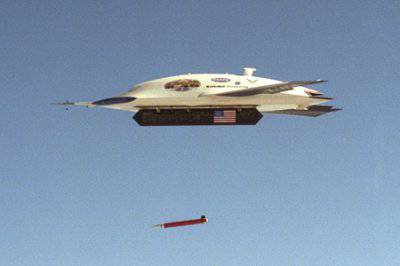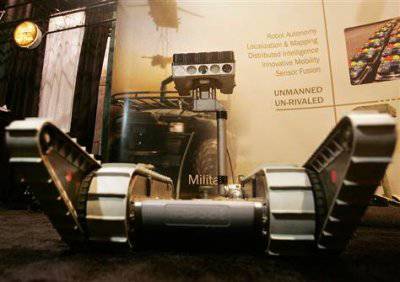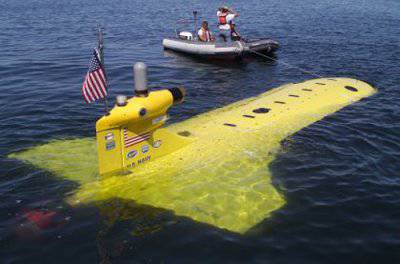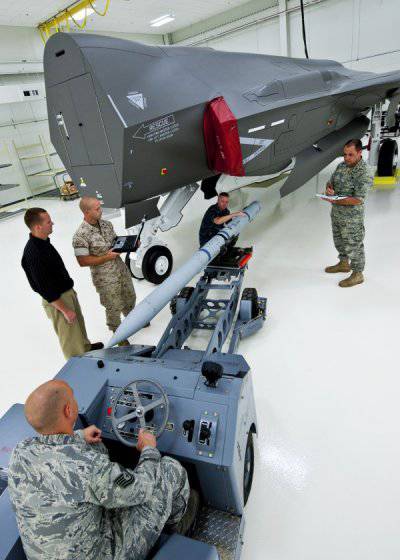Three elements of UAVs
Unmanned or remotely piloted military equipment, as they say, refueled for a long time, but went very quickly. For example, the first specialized flying Drones appeared in the late thirties. But the next few decades, the use of such a technique was extremely rare, and there were not very many types of it. The turning point happened just twenty years ago, when the military of the leading countries realized the full benefits of unmanned aerial vehicles, ground and underwater vehicles. The first serious "PR campaigns" in the media also belong to this time.
In turn, the main influx of finance into the unmanned area happened a little later. So, in the nineties, the Pentagon spent about three billion dollars on all such projects. But after a series of events of the late nineties and the beginning of the two thousandth, they began to allocate much more money to the development of remotely controlled systems. Already in 2003, this figure exceeded one billion, and in 2006 in two. Probably, this growth is to some extent associated with the use of the then unmanned aerial vehicles (primarily flying) in the operation of NATO forces in Afghanistan. As a result, American efforts have no one doubts the effectiveness of unmanned vehicles, if, of course, it is correct to use it for its intended purpose. And yet, despite the wide popularity of the same UAVs, those who move the industry forward remain in the shadows, as well as the creation of other classes of remotely controlled equipment is not widely known.
Little known fame makers
In the 90-ies in the American armed forces with each kind of troops were created so-called. Battle Labs - literally "fighting laboratories". The responsibilities of these organizations include the analysis of the development paths of a kind of troops, as well as the creation of new weapons concepts, their use, etc. The same laboratories are involved in the direct creation of new technology. One of the “Combat Laboratories” was established at Eglin airbase (Florida). Her specialization is unmanned aerial vehicles. At first, the duties of the Eglinsky battle lab included only research on the topic of UAVs, but then, when this class of technology became widespread, laboratory workers began to be involved in the creation of infrastructure for their use. The fact is that even at the beginning of the Afghan operation, NATO found out: to train personnel and allocate space on the base is not enough. For example, unmanned reconnaissance aircraft require a special approach to the transfer of data between units of different levels. The situation is similar with shock drone. The creation of the basics of their use was also done in Eglin, but not independently, but in cooperation with the Combat Laboratory in Quantico (Virginia).
However, the main task of the Eglin laboratory is to work directly on the technical side of the unmanned aviation. Along with research and development work in this Battle Lab conduct tests. So, it was in Eglin that the TCAS system was tested, which allows manned and unmanned aircraft to work in the same area and not interfere with each other. An interesting fact is that development and testing in some areas begin and end, while developments for a number of areas are constantly being created. These include the detection of enemy targets and the use of weapons. In other words, the work of the Aeglene military and engineers is enough.
In addition to the laboratories in Eglin and Kvontiko, other organizations are also involved in various aspects of the use of unmanned aerial vehicles. So, in the centers MBC (Maritime Battle Center - Naval Combat Center) and NSAWC (Naval Strike and Air Warfare Center - Center for Combat Use of Aviation fleet) For many years now they have been working on the integration of unmanned aerial vehicles into the fleet structure. Given certain successes in this direction, we can say that they are working unsuccessfully. In the Central Combat Laboratory of the Ground Forces, as well as in several smaller organizations, the appearance of the use of drones in wars of the near future and the requirements for new devices are being formed. Finally, an organization called JTC / SIL (Joint Technology Center / System Integration Laboratory - Joint Technology Center and System Integration Laboratory) is engaged in global issues of the interaction of drones with various military branches. The tasks of JTC / SIL include the development of the appearance of communication systems at various levels, from the “battlefield” to the strategic, and their creation.
 It is clear why American unmanned aerial vehicles achieved good results and became widely known. In addition, it is clear why the Pentagon allocates such huge sums to the unmanned theme. The US military has long been no secret of their interest in unmanned aerial vehicles. Similarly, another four dozen countries do not hide it. And 32 of them produce UAVs on their own. Interestingly, some of these countries can hardly be called leading in the military industry. Why, then, they produce drones for themselves and for sale? The main reason for this is a certain mobilization of forces. The production of UAVs requires a relatively high level of technology, which has a positive effect on the state’s defense capability. Finally, a large number of drones in the army is a useful touch to the appearance of the future armies.
It is clear why American unmanned aerial vehicles achieved good results and became widely known. In addition, it is clear why the Pentagon allocates such huge sums to the unmanned theme. The US military has long been no secret of their interest in unmanned aerial vehicles. Similarly, another four dozen countries do not hide it. And 32 of them produce UAVs on their own. Interestingly, some of these countries can hardly be called leading in the military industry. Why, then, they produce drones for themselves and for sale? The main reason for this is a certain mobilization of forces. The production of UAVs requires a relatively high level of technology, which has a positive effect on the state’s defense capability. Finally, a large number of drones in the army is a useful touch to the appearance of the future armies.Born to crawl
As you can see, the concept of war without personnel on the battlefield is actively walking around the planet. The same American armed forces have a large number of unmanned aerial vehicles. However, modern warfare is still fought not only in the air. Especially relevant now are ground-based combat vehicles with remote control. Previously, such equipment was used exclusively in units involved in the destruction of explosive devices, but the features of the Iraq and Afghan campaigns showed that it should be in the maximum possible number of units. The realization of this simple fact came to the American command about eight years ago. As a result, 163 remotely controlled Robot, used in hot spots in 2003, in just three years "turned into" more than four thousand. The main purpose of these devices is to search, detect, and sometimes destroy mines, land mines, improvised explosive devices, etc. Unfortunately, such equipment is not yet adapted for active combat operations. Several countries are actively working in this direction at once, but not a single device has yet advanced beyond military tests. It would seem that a sapper robot with cameras, a manipulator, etc., can be equipped weapons and send into the thick of battle. The operator, of course, will not suffer, but the technique is likely to die. In the States, for some time now, it is customary to value the life of a soldier, but they are not even going to throw away expensive equipment there. At least until the advent of relatively cheap robots.
 For this reason, the robot is not yet destined to become an "infantry Vanka", which will go on the attack. At the moment, he is assigned the role of a sapper, a scout and a target designator. For example, the American 3-I mechanized division recently received an experimental batch of robots equipped with a SWORD kit (Special Weapons Observation Remote Reconnaissance Direct Action System - Special equipment for conducting remote patrol and reconnaissance in a collision with an enemy). As is clear from the deciphering of the name, robots with "Svord" are a mobile means of intelligence. Also, the fighters will soon have to familiarize themselves with the REDOWL system (Robotic Enhanced Detection Outpost With Lasers - a robotic improved ambush / post detection using lasers). This system is intended for automated search of enemy optical devices, for example, sniper sights, and issuing coordinates of a detected object. In addition, REDOWL can locate an arrow by the sound of a shot. The stated probability of successful detection by sound is 94%.
For this reason, the robot is not yet destined to become an "infantry Vanka", which will go on the attack. At the moment, he is assigned the role of a sapper, a scout and a target designator. For example, the American 3-I mechanized division recently received an experimental batch of robots equipped with a SWORD kit (Special Weapons Observation Remote Reconnaissance Direct Action System - Special equipment for conducting remote patrol and reconnaissance in a collision with an enemy). As is clear from the deciphering of the name, robots with "Svord" are a mobile means of intelligence. Also, the fighters will soon have to familiarize themselves with the REDOWL system (Robotic Enhanced Detection Outpost With Lasers - a robotic improved ambush / post detection using lasers). This system is intended for automated search of enemy optical devices, for example, sniper sights, and issuing coordinates of a detected object. In addition, REDOWL can locate an arrow by the sound of a shot. The stated probability of successful detection by sound is 94%.Ships without captains, captain without ship
Less well-known, but quite promising way for the development of unmanned vehicles are watercraft with remote control. As in the case of the UAV, this technique was widely used in the 40-s of the last century, but was later forgotten for a long time. Recall that during tests of nuclear munitions in the Pacific, Americans used remote-controlled boats to take water and air samples in the infected areas. Later, several serial boats were equipped with radio control equipment and were extremely limited used on the Vietnamese coast as minesweepers. However, all these were isolated cases that would be more appropriately called technical curiosities than serious projects.
 The first modern experiments to create a full-fledged military unmanned aerial vehicle date back to 1997. Then the general public became aware of the existence of the American project RMOP (Remote Minehunting Operational Prototype - Prototype of a remotely controlled mine minesweeper). It was reported that a boat controlled from the carrier ship successfully completed the training task. For some unknown reason, subsequently News there was very little about the progress of the RMOP project, and the whole topic of remotely controlled boats somehow left the discussion of the military spheres for several years. "Return" took place only in 2003. Then, shortly after the start of another war in Iraq, it became known that for secret operations the US Navy uses unmanned submarines. Details about the boats themselves and the operations they performed were not followed. But soon, the U.S. military officially announced the testing of the Spartan unmanned boat, designed for reconnaissance. But again, the nuances of operations and design were not disclosed. Clearly, this is all military secrecy. In addition, the tests reveal flaws, and the so-called childhood diseases sometimes try to blame the project.
The first modern experiments to create a full-fledged military unmanned aerial vehicle date back to 1997. Then the general public became aware of the existence of the American project RMOP (Remote Minehunting Operational Prototype - Prototype of a remotely controlled mine minesweeper). It was reported that a boat controlled from the carrier ship successfully completed the training task. For some unknown reason, subsequently News there was very little about the progress of the RMOP project, and the whole topic of remotely controlled boats somehow left the discussion of the military spheres for several years. "Return" took place only in 2003. Then, shortly after the start of another war in Iraq, it became known that for secret operations the US Navy uses unmanned submarines. Details about the boats themselves and the operations they performed were not followed. But soon, the U.S. military officially announced the testing of the Spartan unmanned boat, designed for reconnaissance. But again, the nuances of operations and design were not disclosed. Clearly, this is all military secrecy. In addition, the tests reveal flaws, and the so-called childhood diseases sometimes try to blame the project.Apparently, the experiments in the Persian Gulf and in the corresponding Battle Lab led to the creation of a modern concept of unmanned craft. At the moment, the US military believes that this technique should perform the following tasks:
- Conducting intelligence at a small and medium distance from the carrier ship;
- Mine action in areas where aircraft carrier strike groups are located;
- Anti-submarine work. Here, a remote-controlled boat can search for enemy submarines, target designation of aircraft and ships, or even independently attack the detected target;
- Shock functions. A small-sized remote-controlled ship can carry out attacks of objects with weak protection with high efficiency. This option of using unmanned boats can be considered as a development of the concept of mosquito fleet;
- The tasks of information and radio-electronic nature, such as the retransmission of communication signals, electronic intelligence or jamming.
In addition to the principles of application in the depths of the American military machine, the classification of unmanned ships was born. For obvious reasons, weight and dimensional parameters were taken for its basis, from which the running, combat and other qualities can follow. Currently, existing and future floating drones are divided into four categories:
- X-Class. Small drones smaller than a standard rubber boat. Due to its small size, the X-Class can only perform reconnaissance missions, since for more simply do not have enough capacity;
- Harbor Class. A more serious machine larger than the X-Class. As a basis for this class, a standard US army inflatable boat with a rigid frame or, alternatively, small boats is offered. The class is also intended primarily for reconnaissance, but a large carrying capacity allows it to be equipped with more or less serious weapons;
- Snorkeler Class. This includes all unmanned underwater vehicles. Theoretically, they can perform the whole range of tasks issued to the unmanned fleet, but so far experienced specimens can only conduct reconnaissance. In the next few years, Snorkelers are expected to master anti-submarine work;
- Fleet Class. The largest representative of the American classification. Drones of this class should be created on the basis of serial boats. In order not to be confused with the Harbor Class, a distinction in size and displacement has been introduced. For example, the Fleet-class includes all surface drones longer than 10-11 meters. Representatives of the Fleet Class can be used for all necessary tasks, you should only install the appropriate set of equipment. In addition, the "Fleet-class" can perform transport functions, transporting goods and people.
Future
The main desire associated with the drones of the future concerns their complete autonomy. Modern remotely piloted aircraft and floating vehicles are highly susceptible to electronic warfare. If you believe a certain source of the newspaper The Christian Science Monitor, it was EW that helped Iran in December last year to take over the American drone. The best way out of the situation would be to equip the device with an electronic “brain” capable of performing the task independently without human intervention. However, this requires a full-fledged artificial intelligence, even if sharpened for specific purposes. And in this area, as they say, accessory manufacturers have failed. Scientists all over the world have been struggling with this problem for several years now and, unfortunately, a full-fledged “AI” remains a matter for not even tomorrow.
Much more realistic is the further development of the materials used. For example, the issue of the use of biopolymers is being actively studied. Such materials should be a substitute for used carbon-fiber based composites. At the same time, the prefix "bio" in some way complicates the task, because it involves obtaining the necessary substances from natural materials. In the future, to ensure the unmanned aircraft industry, it will be necessary to create new plant varieties that produce the necessary materials. But so far scientists have not yet decided on which biopolymer should be “taken away” from nature and is still far from selection or gene modification. Do not forget to nanotechnology. Despite the ironically skeptical halo that has developed around them, they are indeed one of the most promising areas in science. The main scope of nanotechnology, where they will be most useful for UAVs, is microelectronics. In the future, it is nanotechnology that will help to significantly increase the performance of systems, which is directly related to the ability of the electronic “brain” to learn and think.
Now, not knowing exactly how the development of unmanned military equipment will proceed, it is early to talk about specific trends. However, one conclusion can be made now. As it was at all stages of progress, new technologies, new devices and new know-how will be more expensive than the old ones. And so for a serious leap in the field of unmanned vehicles will require serious investment. The country that has overpowered them will not only become the industry leader, but will even be able to influence the development of all science and technology combined.

Information